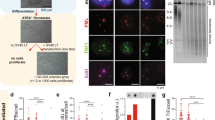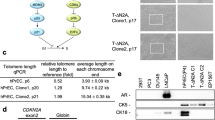Abstract
Exogenous expression of the catalytic subunit of telomerase, hTERT, in a normal human foreskin fibroblast cell strain resulted in telomerase activity and an extended proliferative lifespan prior to a period of crisis. Three immortalized cell lines with stably maintained telomere lengths were established from cells that escaped crisis. Each of these cultures underwent a significant downregulation of p16INK4a expression due to gene deletion events. One cell line also acquired mutations in both alleles of the p53 tumor suppressor gene. Downregulation of p16INK4a and loss of wild-type p53 expression occurred after escape from crisis, so these mutations are most likely not required for immortalization of these cells but rather were selected for during continuous growth in vitro. These findings emphasize the need for caution in the use of hTERT-immortalized cells in studies of normal cell biology or in tissue engineering and the need to monitor for genetic instability and the accumulation of mutations in both the p16INK4a/pRb and p53 pathways.
This is a preview of subscription content, access via your institution
Access options
Subscribe to this journal
Receive 50 print issues and online access
$259.00 per year
only $5.18 per issue
Buy this article
- Purchase on Springer Link
- Instant access to full article PDF
Prices may be subject to local taxes which are calculated during checkout




Similar content being viewed by others
References
Bodnar AG, Ouellette M, Frolkis M, Holt SE, Chiu C-P, Morin GB, Harley CB, Shay JW, Lichtsteiner S and Wright WE . (1998). Science, 279, 349–352.
Bryan TM, Englezou A, Gupta J, Bacchetti S and Reddel RR . (1995). EMBO J., 14, 4240–4248.
Bryan TM and Reddel RR . (1994). Crit. Rev. Oncogenesis, 5, 331–357.
Campisi J . (2001). Trends Cell Biol., 11, S27–S31.
Clark SJ, Harrison J, Paul CL and Frommer M . (1994). Nucleic Acids Res., 22, 2990–2997.
Colgin LM and Reddel RR . (1999). Curr. Opin. Genet. Dev., 9, 97–103.
Colgin LM, Wilkinson C, Englezou A, Kilian A, Robinson MO and Reddel RR . (2000). Neoplasia, 2, 426–432.
Counter CM, Avilion AA, LeFeuvre CE, Stewart NG, Greider CW, Harley CB and Bacchetti S . (1992). EMBO J., 11, 1921–1929.
Farwell DG, Shera KA, Koop JI, Bonnet GA, Matthews CP, Reuther GW, Coltrera MD, McDougall JK and Klingelhutz AJ . (2000). Am. J. Pathol., 156, 1537–1547.
Franco S, MacKenzie KL, Dias S, Alvarez S, Rafii S and Moore MAS . (2001). Exp. Cell Res., 268, 14–25.
Girardi AJ, Jensen FC and Koprowski H . (1965). J. Cell Comp. Physiol., 65, 69–84.
Harland M, Holland EA, Ghiorzo P, Mantelli M, Bianchi-Scarra G, Goldstein AM, Tucker MA, Ponder BA, Mann GJ, Bishop DT and Newton BJ . (2000). Genes Chromosomes Cancer, 28, 45–57.
Harley CB . (1991). Mutat. Res., 256, 271–282.
Hayflick L and Moorhead PS . (1961). Exp. Cell Res., 25, 585–621.
Holland EA, Beaton SC, Becker TM, Grulet OMC, Peters BA, Rizos H, Kefford RF and Mann GJ . (1995). Oncogene, 11, 2289–2294.
Huschtscha LI and Holliday R . (1983). J. Cell Sci., 63, 77–99.
Huschtscha LI, Noble JR, Neumann AA, Moy EL, Barry P, Melki JR, Clark SJ and Reddel RR . (1998). Cancer Res., 58, 3508–3512.
Jiang XR, Jimenez G, Chang E, Frolkis M, Kusler B, Sage M, Beeche M, Bodnar AG, Wahl GM, Tlsty TD and Chiu CP . (1999). Nat. Genet., 21, 111–114.
Kaul SC, Yaguchi T, Taira K, Reddel RR and Wadhwa R . (2003). Exp. Cell Res., 286, 96–101.
Kim H, Farris J, Christman SA, Kong BW, Foster LK, O'Grady SM and Foster DM . (2002). Biochem. J., 365, 765–772.
Kim NW, Piatyszek MA, Prowse KR, Harley CB, West MD, Ho PLC, Coviello GM, Wright WE, Weinrich SL and Shay JW . (1994). Science, 266, 2011–2015.
Kiyono T, Foster SA, Koop JI, McDougall JK, Galloway DA and Klingelhutz AJ . (1998). Nature, 396, 84–88.
Lane DP and Benchimol S . (1990). Genes Dev., 4, 1–8.
MacKenzie KL, Franco S, May C, Sadelain M and Moore MAS . (2000). Exp. Cell Res., 259, 336–350.
McGregor F, Muntoni A, Fleming J, Brown J, Felix DH, MacDonald DG, Parkinson EK and Harrison PR . (2002). Cancer Res., 62, 4757–4766.
Morales CP, Holt SE, Ouellette M, Kaur KJ, Yan Y, Wilson KS, White MA, Wright WE and Shay JW . (1999). Nat. Genet., 21, 115–118.
Noble JR, Rogan EM, Neumann AA, Maclean K, Bryan TM and Reddel RR . (1996). Oncogene, 13, 1259–1268.
O'Hare MJ, Bond J, Clarke C, Takeuchi Y, Atherton AJ, Berry C, Moody J, Silver ARJ, Davies DC, Alsop AE, Neville AM and Jat PS . (2001). Proc. Natl. Acad. Sci. USA, 98, 646–651.
Olivier M, Eeles R, Hollstein M, Khan MA, Harris CC and Hainaut P . (2002). Hum. Mutat., 19, 607–614.
Olovnikov AM . (1973). J. Theor. Biol., 41, 181–190.
Paul CL and Clark SJ . (1996). Bio Techniques, 21, 126–133.
Perrem K, Bryan TM, Englezou A, Hackl T, Moy EL and Reddel RR . (1999). Oncogene, 18, 3383–3390.
Reddel RR . (2000). Carcinogenesis, 21, 477–484.
Rogan EM, Bryan TM, Hukku B, Maclean K, Chang ACM, Moy EL, Englezou A, Warneford SG, Dalla-Pozza L and Reddel RR . (1995). Mol. Cell. Biol., 15, 4745–4753.
Rooney DE and Czepulkowski, BH . (1992). Human Cytogenetics: A Practical Approach. Vol I. Constitutional Analysis. Oxford University Press: Oxford.
Shay JW and Wright WE . (1989). Exp. Cell Res., 184, 109–118.
Toouli CD, Huschtscha LI, Neumann AA, Noble JR, Colgin LM, Hukku B and Reddel RR . (2002). Oncogene, 21, 128–139.
Tsutsui T, Kumakura SI, Yamamoto A, Kanai H, Tamura Y, Kato T, Anpo M, Tahara H and Barrett JC . (2002). Carcinogenesis, 23, 2111–2117.
Vaziri H and Benchimol S . (1998). Curr. Biol., 8, 279–282.
Vaziri H, Squire JA, Pandita TK, Bradley G, Kuba RM, Zhang H, Gulyas S, Hill RP, Nolan GP and Benchimol S . (1999). Mol. Cell. Biol., 19, 2373–2379.
Von Zglinicki T . (2002). Trends Biochem. Sci., 27, 339–344.
Weinrich SL, Pruzan R, Ma L, Ouellette M, Tesmer VM, Holt SE, Bodnar AG, Lichtsteiner S, Kim NW, Trager JB, Taylor RD, Carlos R, Andrews WH, Wright WE, Shay JW, Harley CB and Morin GB . (1997). Nat. Genet., 17, 498–502.
Wright WE, Pereira-Smith OM and Shay JW . (1989). Mol. Cell. Biol., 9, 3088–3092.
Wright WE and Shay JW . (2002). Nat. Biotechnol., 20, 682–688.
Acknowledgements
This work was supported by a project grant from the National Health and Medical Research Council of Australia, and the Carcinogenesis Fellowship of the Cancer Council New South Wales. We thank Christine Smyth for FACscan analysis, Alessandra Muntoni for advice on p53 sequencing, and Helen Rizos for advice on p16INK4a PCR analysis.
Author information
Authors and Affiliations
Corresponding author
Rights and permissions
About this article
Cite this article
Noble, J., Zhong, ZH., Neumann, A. et al. Alterations in the p16INK4a and p53 tumor suppressor genes of hTERT-immortalized human fibroblasts. Oncogene 23, 3116–3121 (2004). https://doi.org/10.1038/sj.onc.1207440
Received:
Revised:
Accepted:
Published:
Issue Date:
DOI: https://doi.org/10.1038/sj.onc.1207440
Keywords
This article is cited by
-
A prospect of cell immortalization combined with matrix microenvironmental optimization strategy for tissue engineering and regeneration
Cell & Bioscience (2019)
-
Biomedical applications of microbially engineered polyhydroxyalkanoates: an insight into recent advances, bottlenecks, and solutions
Applied Microbiology and Biotechnology (2019)
-
Characteristics of primary and immortalized fibroblast cells derived from the miniature and domestic pigs
BMC Cell Biology (2007)
-
Disruption of the retinoblastoma pathway by small interfering RNA and ectopic expression of the catalytic subunit of telomerase lead to immortalization of human ovarian surface epithelial cells
Oncogene (2007)
-
Strict control of telomerase activation using Cre-mediated inversion
BMC Biotechnology (2006)



